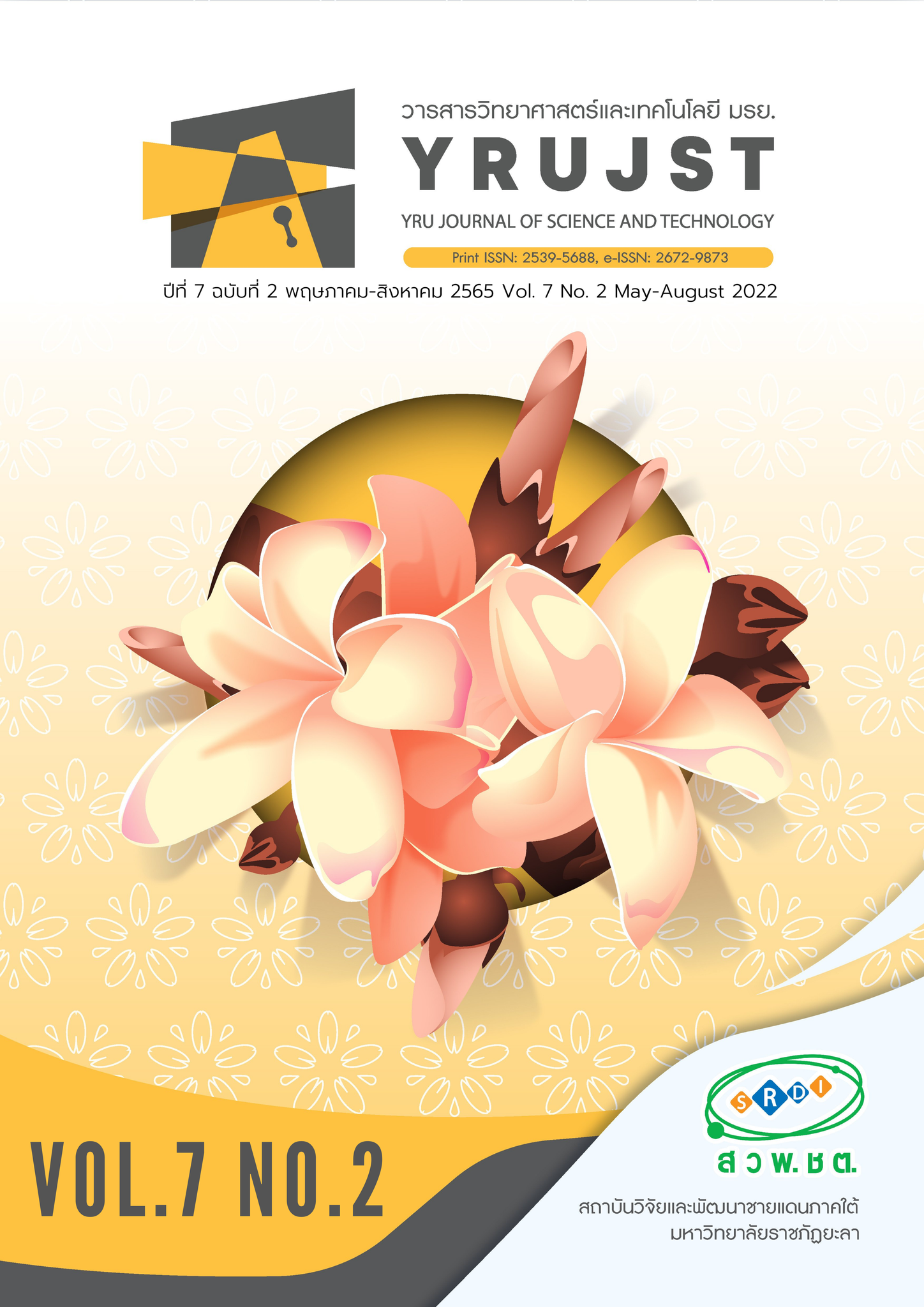การประเมินการได้รับปริมาณก๊าซเรดอนภายในอาคารที่มีผลต่อการเกิดโรคมะเร็งปอดในบริเวณพื้นที่อำเภอเมือง จังหวัดยะลา
Main Article Content
บทคัดย่อ
ปัจจุบันหลายประเทศให้ความสำคัญกับคุณภาพภายในอาคารที่มีผลต่อสุขภาพของผู้อยู่อาศัยเป็นอย่างมาก โดยเฉพาะอย่างยิ่งการได้รับปริมาณก๊าซเรดอน (222Rn) ซึ่งเป็นสารกัมมันตรังสีที่มีอยู่ในธรรมชาติที่ส่งผลต่อการก่อให้เกิดมะเร็งปอดในมนุษย์ งานวิจัยนี้มีวัตถุประสงค์เพื่อวัดปริมาณความเข้มข้นของก๊าซเรดอนภายในอาคาร และประเมินปัจจัยเสี่ยงจากการได้รับก๊าซเรดอนที่สัมพันธ์กับการเกิดโรคมะเร็งปอด บริเวณอำเภอเมือง จังหวัดยะลา โดยใช้ชุดตรวจวัดก๊าซเรดอน ชนิดแผ่นพลาสติก CR-39 ติดตั้งภายในอาคารบ้านเรือน รวมทั้งสิ้น 90 ตัวอย่าง เป็นเวลา 40 วัน แล้วกัดขยายรอยแฝงรังสีแอลฟาด้วยเงื่อนไขที่เหมาะสม คือ ใช้สารละลายโซเดียมไฮดรอกไซด์ (NaOH) ที่มีความเข้มข้น 6.25 mol/L อุณหภูมิ 85๐ C เป็นเวลา 100 นาที ผลการตรวจวัดความเข้มข้นของก๊าซเรดอนในอาคาร พบว่ามีค่าตั้งแต่ 20.70 ± 3.44 ถึง 24.57 ± 6.30 Bq/m3 มีค่าเฉลี่ยเท่ากับ 22.63 ± 1.74 Bq/m3 โดยพบค่าต่ำสุดในตำบลบุดี และค่าสูงสุดในตำบลลำใหม่ สำหรับการประเมินความเสี่ยงในการก่อให้เกิดโรคมะเร็งในตลอดช่วงชีวิต (ELCR) มีค่าเฉลี่ยเท่ากับ 2.20 x 10-3 ซึ่งสูงกว่าค่ามาตรฐานที่คณะกรรมการวิทยาศาสตร์แห่งสหประชาชาติว่าด้วยผลกระทบจากรังสี (UNSCEAR) กำหนด คือ 0.29 x 10-3 อย่างไรก็ตามเมื่อพิจารณาค่าเฉลี่ยของโอกาสการเกิดจำนวนผู้ป่วยมะเร็งปอดต่อปีต่อล้านคน (LCC) มีค่าเท่ากับ 10.27 ซึ่งมีค่าต่ำกว่าเกณฑ์มาตรฐานขององค์การสากลในการป้องกันอันตรายจากรังสี (ICRP) กำหนดไว้ในช่วง 170 - 230 ต่อปีต่อล้านคน แสดงให้เห็นว่าพื้นที่ศึกษานี้ไม่มีความเสี่ยงในการเกิดมะเร็งปอดจากปริมาณก๊าซเรดอนในอาคารบ้านเรือน
Article Details

อนุญาตภายใต้เงื่อนไข Creative Commons Attribution-NonCommercial-NoDerivatives 4.0 International License.
บทความ ข้อมูล เนื้อหา รูปภาพ ฯลฯ ที่ได้รับการเผยแพร่ในวารสารวิทยาศาสตร์และเทคโนโลยี มรย. นี้ ถือเป็นลิขสิทธิ์ของวารสารวิทยาศาสตร์และเทคโนโลยี มรย. หากบุคคลหรือหน่วยงานใดต้องการนำทั้งหมดหรือส่วนหนึ่งส่วนใดไปเผยแพร่ต่อหรือกระทำการใดๆ จะต้องได้รับอนุญาตเป็นลายลักษณ์อักษรจากวารสารวิทยาศาสตร์และเทคโนโลยี มรย. ก่อนเท่านั้น
เอกสารอ้างอิง
BEIR VI. (1999). Report of the Committee on Health Risk of Exposure to Radon; Board on Radiation Effects Research. National Research Council. Washington, DC: National Academy Press.
Bhongsuwan, T., Chittrakarn, T., Chongkum, S., Polapongs, P., Sirijarukal, S., Thitipornpan. A., et al. (2001) Radon risk assessment, indoor/outdoor to public communities in Songkhla Lake Basin. The 8th Nuclear Science and Technology Conference, June 20-21, 2001. Bangkok: Thailand. (in Thai).
Chen, J., Rahman, N.M., & Atiya, I.A. (2010). Radon exhalation from building materials for decorative use. Journal of Environmental Radioactivity, 101(4), 317–322.
Imsamran, W., Chaiwerawattana, A., Wiangnon, S., Pongnikorn, D., Suwanrungruang, K., Sangrajran, S., et al. (2015). Cancer in Thailand vol. VIII 2010-2012. Bangkok: National center institute.
International Agency for Research on Cancer (IARC). (2018). Global cancer burden. [online]. Retrieved November 23, 2021. From: https://www.iarc.who.int/wp-content/uploads/2018/09/pr263_E.pdf.
International Commission on Radiological Protection (ICRP). (1987). Lung cancer risk from exposure to radon daughters. ICRP 50. Ann, 17, 1–57.
International Commission on Radiological Protection (ICRP). (1990). Recommendations of the International Commission on Radiological Protection. ICRP Publication 60. Oxford: Pergamon Press.
International Commission on Radiological Protection (ICRP). (2010). Lung Cancer Risk from Radon and Progeny and Statement on Radon. ICRP Publication. Oxford: Pergamon Press.
Kaewtubtim, P., Sola, P., & Kongpakdee, T. (2019). Radon concentration and radon exhalation rate from rock samples used for construction at northern part of yala province. UTK Research Journal, 13(2), 187-197. (in Thai).
Kim S.H, Hwang W.J., Cho, J.S., & Kang, D.R. (2016). Attributable risk of lung cancer deaths due to indoor radon exposure. Annals of Occupational and Environmental Medicine, 28(8), 1-7.
Panpiboon, P., Atyotha, V., Choawanklarng, V,. & Sola, P. (2016). Measuring the concentration of radon in the air at Mueang district, Mahasarakham province. Research report. Faculty of Science and Technology, Rajabhat Maha Sarakham University. (in Thai).
Pisapak P. (2017). Spatial and Temporal Variations of Radon and their Applications:
A Case Study on Southern Thailand. Doctor of Philosophy of Science Thesis in Geophysics, Prince of Songkla University.
Ploysawang, P., Joosawat. A., Jamsri, P., Pangmuang, P. & Sangrajrang. (2021). Assessment of Cancer Knowledge among Department of Medical Services Staffs. Thai cancer Journal, 41(1), 12-23. (in Thai).
Sakoda, A., Hanamoto, K., Ishimori, Y., Nagamatsu, T. & Yamaoka, K. (2008). Radioactivity and radon emanation fraction of the granites sampled at Misasa and Badgastein. Applied Radiation and Isotopes, 66(5), 648–652.
Sherafat, S., Mansour, S. N., Moaferi, M., Aminiani, N., Yousafi, Z., & Maleki, S. (2019). First indoor radon mapping and assessment excess lifetime cancer risk in Iran. MethodsX. 6, 2205-2216.
Srisuwan, T. (2016). Radon: The Hidden Hazard in building. Joural of Architectural/Planning Research and Studies, 4(2), 23-37. (In Thai).
Titiponpun, A. (1999). Indoor-Outdoor Radon Concentration Measurement in Songkhla Province Area. Master of Science Thesis in Physics. Prince of Songkla University. (In Thai).
United Nations Scientific Committee on the Effects of Atomic Radiation (UNSCEAR). (2000). Sources and effects of atomic radiation, Report to General Assembly, Annex B. United Nations, New York.
United States Department of Health and Human Services (HHS). (2005). Surgeon General Releases National Advisory on Radon. Atlanta, G A: HHS Press Office.
United States Environmental Protection Agency (US EPA). (1992). National emission standards for hazardous air pollutants: Emission standards for radon emissions from phosphogypsum stacks, Federal Register.57(107), Final Rule (40CFR61).
Vatanasapt, V., Martin, N., Sriplung, H., Chindavijak, K., Sontipong, S., Sriamporn, H., et al. (1995). Cancer incidence in Thailand, 1988-1991. Cancer Epidemiol Biomakers Prev. 4, 475-483.


